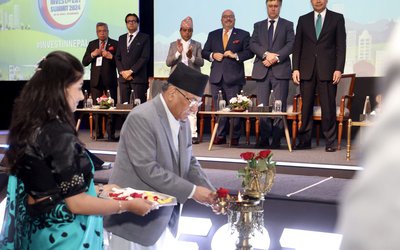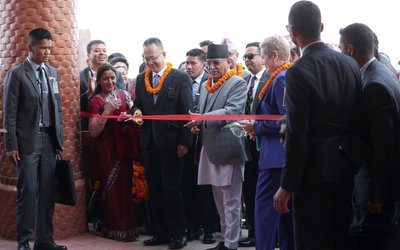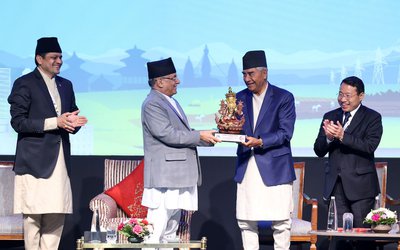
The 2023/024 Policy and Program of the Government commits, inter alia, to promote sustainable and green economy, and enact development projects-related laws to simplify: (i) land acquisition; (ii) utilization of forest area; (iii) Environmental Impact Assessment (EIA); and (iv) procurement process. The Policy and Program realizes the need for ensuring no adverse impacts on the environment while collecting stones, aggregates, and sands from rivers. The Budget Speech commits to carryout EIA to reduce adverse impacts on the Chure environment while utilising these stones and aggregates. The government has reemphasized the enforcement of legal provisions on EIA.
All countries have adopted and best utilized the EIA process to make their development environment-friendly and sustainable. The multilateral development banks such as the World Bank and the Asian Development Bank require to following national system on EIA or impose their requirements before implementing any prescribed environmentally sensitive projects with their support.
Nepal has internalized and institutionalized EIA process since the last 3 decades through guidelines, and over two and half decades though environmental laws. The government does not say anything about which of the process of the EIA or its legal provision is complicated and has hindered implementation of the physical infrastructure and economic development projects. Making a public statement that EIA is a barrier for economic development process is common in Nepal from the last 27 years. Some 'influential' people blame this globally accepted and all-countries-used EIA tool a process that delays the development. There are examples of approval of EIA report in one day (total 31 days, including 30 days legally made the report public) or within time as mentioned in the law. It should be and can be done.
If the government considers the 'cost of delay decision', there are several ways for improvements. The government can: (i) mobilise a 'professional team' and introduce a 'fast-track' decision-making process; (ii) amend Environment Protection Rules (2020) and its schedules by following the EIA principles, global practices, national experiences, and learning; (iii) issue EIA report review criteria; (iv) develop a system to issue a license to the consulting firms and/or the individuals to prepare EIA report; (v) designate independent reviewers (not consultants) for EIA report review; and (vi) ensure environmental monitoring and auding and use results to prepare EIA report of similar projects. If under-quality EIA report is submitted, it can enforce the existing legal provisions. In spite of these improvements, if under-quality EIA report is approved, it can take actions to the approving person(s) engaged in approval process. EIA process does not block the development but may propose costly adverse impacts mitigation measures for 'environmentally highly sensitive' projects. Impacts largely depend upon the location of the project, people and 'valued' resources to be adversely impacted.
The government approved the so-called EIA report of the Nijgadh international airport which is not an EIA report of the airport technically.
Nepal Rastra Bank has issued a Guideline on Environmental and Social Risk Management (ESRM) for Banks and Financial Institutions in February 2022 by revising its 2018 Guideline. It guides banks and financial institutions to provide loan to any projects by ensuring the management of environmental and social risks. The project having government's approved 'under-quality' EIA report may not receive required loan from banks and financial institutions. In other countries, banks and financial institutions have stringent policies and mechanisms to ensure and manage project-induced environmental and social risks.
Environmental Assessment [Initial Environmental Examination (IEE) or EIA] - project level assessment - provides multiple options to make the physical infrastructure, economic, and social development environment-friendly and sustainable. It uses scientific tool to assess impacts and provides options to manage significant impacts. IEE or EIA, being a predictive tool and being carried out during pre-feasibility and feasibility study stages, in principle, is not a panacea to solve construction and operational challenges of any project. It simply provides multiple opportunities to augment beneficial impacts and mitigate adverse ones.
Nepal's environmental law also provisions for the approval of Supplementary EIA (SuEIA) report. This concept emerged when the Kulekhani Hydroelectricity Project-III proposed to reduce its installed capacity in the decade of 2000s. To streamline infrastructure development and approval process, then Ministry of Population and Environment issued a Supplementary EIA Guideline in January 2015 (BS 2071). The Guideline guides for preparing and approving the SuEIA report. This is now provisioned in the environmental laws.
Section 11 of the Environment Protection Act (2019) provisions to carry out SuEIA if the proponent plans to make some revision in the physical infrastructure, design or form, transfer or alter the structure of any project, add forest area, or increase the capacity of the project to ascertain adverse impacts on the environment. The proponent should apply to the concerned body along with the reasons (why SuEIA is necessary), comparative table of environmental indicators and other necessary justifications. The Act provisions say that the concerned body may order to submit a SuEIA or may give permission as per the application. Rules (11) of the Environment Protection Rules (2020) elaborate the SuEIA report approval process. The law exempts the scoping and ToR, and provisions to follow the EIA report approval process with recommendation letter of only the local level. The concerned body may also instruct to simply revise the environmental management plan (EMP) of the approved EIA report to exempt from the SuEIA process. Similar provisions exist for revision of brief environmental study and IEE reports.
Interestingly, SuEIA is carried out without specific ToR. Multiple challenges crop up during the implementation of the approved generic EIA report. If the defined direct impact zone is same, additional scope of work is undefined, and ToR does not specify areas for further study, question arises on the need for SuEIA. In general understanding, impacts will occur in defined direct impact zone and may occur in 'indirect impact zone' and 'surrounding areas'. If the change (as mentioned in EPA, 2019) is limited to defined direct impact zone, SuEIA would not be technically required with the assumption that approved EIA report has sufficiently evaluated impacts of this zone and this can be addressed through EMP which is also provisioned in the EPR, 2020. Similar study for brief environmental study can be rethought.
As mentioned above, environmental assessment is a predictive tool. It uses seven words - (impacts) identification, prediction, evaluation, avoidance, minimisation, compensation, and augmentation. Environmental assessment must evaluate the significance of identified and predicted impacts. For evaluated significant impacts, EIA proposes to avoid, minimise, or compensate the adverse impacts, and enhance the beneficial impacts. In Nepal's approved IEE or EIA reports, impact evaluation is remarkably weak. In most cases, all impacts identified or predicted are considered significant even in case such impacts are not directly related to the project activities.
A fact-based and quality IEE or EIA report provides multiple options to mitigate adverse environmental impacts for long-lasting benefits from projects, by integrating measures into projects' detail design and implementing them as an integral part of the project activities.

Batu Uprety
Former Joint-Secretary and Chief of Climate Change Management Division, Ministry of Environment (then), and former Team Leader, National Adaptation Plan (NAP) formulation process. E-mail: upretybk@gmail.com
- Dialogue On Mountains And Climate Change Planned
- Apr 19, 2024
- Institutional Response And Leadership on Climate Negotiations
- Mar 28, 2024
- The Wire Without A Current
- Mar 20, 2024
- Call For Degazetting the Shivapuri-Nagarjun National Park
- Feb 08, 2024
- Advancing Need-Based Adaptation Options
- Jan 14, 2024















